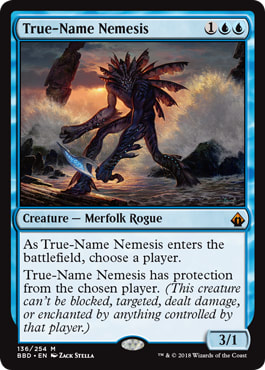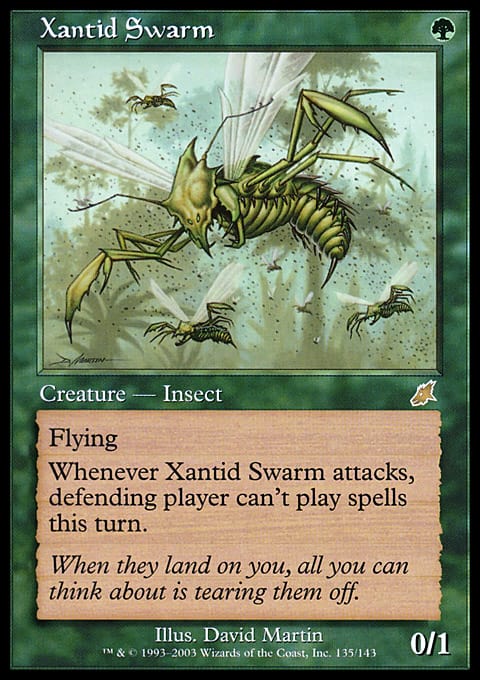Hey there! I have been playing a fair bit of Legacy to prepare for the upcoming Finnish Legacy Championships. This, along with the increased interest in Legacy due to the recent Grand Prix, led me to the thought that writing an article about Legacy might be appropriate.
As most of you who follow Legacy have noticed, True-Name Nemesis is the new boogeyman on the block, and it’s among the most defining cards in recent Legacy history. As I see it, there are three approaches that you can take to combat the Nemesis. The first is to play fair and try to answer the threat with some answers while potentially playing your own copies of the card. The second is to play fair but try to ignore True-Name Nemesis as best you can so that you don’t have to tangle with it in combat. The third strategy is to just ignore it completely and not play fair at all, aiming to kill your opponent before the Trained Armodon starts doing damage.
While I am not as concerned about the power level of the card as some people are, I do think it is good and something that you need to take into consideration while building your deck and choosing what to play. In this article, I will try to give some recommendations as to which decks are alternatives for each of these three strategic approaches, and finally, I’ll talk a bit about which deck I like the best in Legacy at the moment. It’s worth noting that it might take some time for the metagame to catch up in various areas, mainly due to card availability when a new limited release set, like Commander, comes along. This means that some strategies I recommend might not be that good for your local area—if people are not playing True-Name Nemesis yet.
Fighting It
I think Shardless B/U/G has some very reasonable options for fighting True-Name Nemesis as a card, as Liliana of the Veil, Toxic Deluge, and Golgari Charm are excellent at taking care of it. You can even run Engineered Plague if you really want to hate on the 3/1 while also having an excellent card against Elves! Here is a sample decklist, very slightly tuned from the one Ted McCluskie used to make Top 8 at Grand Prix DC.
"Shardless B/U/G"
- Creatures (12)
- 4 Deathrite Shaman
- 4 Shardless Agent
- 4 Tarmogoyf
- Planeswalkers (5)
- 2 Jace, the Mind Sculptor
- 3 Liliana of the Veil
- Spells (21)
- 1 Toxic Deluge
- 4 Abrupt Decay
- 4 Brainstorm
- 4 Force of Will
- 2 Hymn to Tourach
- 2 Thoughtseize
- 4 Ancestral Vision
- Lands (22)
- 2 Bayou
- 2 Creeping Tar Pit
- 2 Misty Rainforest
- 2 Tropical Island
- 2 Wasteland
- 4 Polluted Delta
- 4 Underground Sea
- 4 Verdant Catacombs
- Sideboard (15)
- 2 Baleful Strix
- 3 Golgari Charm
- 2 Thoughtseize
- 1 Hymn to Tourach
- 2 Flusterstorm
- 1 Umezawa's Jitte
- 2 Nihil Spellbomb
- 1 Toxic Deluge
- 1 Maelstrom Pulse
The main deck is practically the same except for the third Liliana and the one Toxic Deluge. I feel that Baleful Strix is not that great at the moment, but it might be that you still want to play one or two in the main deck to give the deck some more flow. There are more changes in the sideboard than in the main deck, and for Games 2 and 3, you have very many answers to the annoying Merfolk. For post-sideboard games, you should also be fairly well positioned against Elves and Death & Taxes, two decks that have become very popular lately.
Ignoring It
My current preference for not having to directly deal with True-Name Nemesis is Miracles. While the hexproof part does prevent you from casting Swords to Plowshares on it, you are not really interested in going into combat with it, which is where I think the protection matters the most. You have four Terminus that handle the Nemesis very easily; plus, you have counters to stop it from coming into play if the situation requires that. I have been playing Miracles with a red splash, which seems to be the common choice lately. I still think black is slightly better if you are expecting a lot of combo—even though no longer playing Snapcaster Mage makes Thoughtseize worse.
"W/U/r Miracles"
- Creatures (3)
- 3 Vendilion Clique
- Planeswalkers (4)
- 4 Jace, the Mind Sculptor
- Spells (30)
- 2 Counterspell
- 2 Spell Pierce
- 4 Brainstorm
- 4 Force of Will
- 4 Swords to Plowshares
- 2 Entreat the Angels
- 4 Terminus
- 1 Rest in Peace
- 3 Counterbalance
- 4 Sensei's Divining Top
- Lands (23)
- 2 Plains
- 5 Island
- 1 Arid Mesa
- 2 Mystic Gate
- 2 Tundra
- 2 Volcanic Island
- 3 Scalding Tarn
- 4 Flooded Strand
- 2 Karakas
- Sideboard (15)
- 2 Swan Song
- 2 Pyroblast
- 2 Blood Moon
- 2 Enlightened Tutor
- 1 Humility
- 1 Rest in Peace
- 1 Moat
- 1 Oblivion Ring
- 1 Ethersworn Canonist
- 1 Counterbalance
- 1 Pithing Needle
I have been fairly pleased with the deck, and it is nice that the sideboard is super-versatile so you can tweak it for your own metagame. The one Rest in Peace in the main is something I picked up from Drew Levin’s article, and I’m no stranger to running the one Rest in Peace in other formats either. The mana base is a bit of a question mark at the moment—I am not quite sure about the Mystic Gates and the second Karakas. However, Karakas is so amazing against Sneak & Show that it is probably worth running two copies. It is also very nice against Death & Taxes as a way to temporarily get rid of Thalia, Guardian of Thraben.
If you are interested in my thoughts about Miracles in general, you can have a look at the article I wrote after Grand Prix Ghent. Even though it has almost been eighteen months since then, I still think the concepts are mostly relevant.
Ignoring Them
The third strategy is to not just ignore True-Name Nemesis, but ignore most of what your opponent is doing, and just go for the kill as fast as possible without any unnecessary interaction involved. There are a lot of very reasonable combo choices at the moment, with the four best being Elves, Reanimator, Sneak & Show, and ANT, in no particular order. I have been playing a bit of ANT lately, so that was an easy choice for the unfair choice.
This main deck is identical to the one Timo Schuenemann used to Top 8 the recent Bazaar of Moxen, and Timo has fared very well with the deck previously, so I would trust his take on it.
"ANT"
- Spells (45)
- 1 Ad Nauseam
- 4 Brainstorm
- 4 Cabal Ritual
- 4 Dark Ritual
- 1 Past in Flames
- 1 Tendrils of Agony
- 2 Preordain
- 3 Duress
- 4 Cabal Therapy
- 4 Gitaxian Probe
- 4 Infernal Tutor
- 4 Ponder
- 1 Sensei's Divining Top
- 4 Lion's Eye Diamond
- 4 Lotus Petal
- Lands (15)
- 1 Island
- 1 Swamp
- 1 Bayou
- 1 Tropical Island
- 1 Volcanic Island
- 2 Underground Sea
- 4 Misty Rainforest
- 4 Polluted Delta
- Sideboard (15)
- 3 Carpet of Flowers
- 3 Abrupt Decay
- 3 Dread of Night
- 2 Dark Confidant
- 2 Xantid Swarm
- 1 Ad Nauseam
- 1 Chain of Vapor
I am currently trying out the two-and-two split on Dark Confidant and Xantid Swarm, as I’ve felt I need something against decks that are heavy on discard effects. Other than that, the sideboard is fairly identical to the one Timo played at the Bazaar of Moxen. I’ve been thinking about perhaps running a single Golgari Charm—or potentially Massacre—as there are some problematic creatures that you would like to deal with. However, I think Abrupt Decay is so great, due to the flexibility, that you can’t really cut any. I’ve been very pleased with this version of Storm, and it does very powerful things but is still somewhat resilient—unlike some combo decks in Legacy.
Finnish Champs
The Finnish metagame is interesting because R/U/G Delver is often much underrepresented while Stoneblade and its variants are very popular among Finnish players. There are also often more MUD decks present than you would expect in other parts of the world, and there are usually fewer Miracles decks. Other than that, there is the usual variety of decks that you can expect at a Legacy tournament; that is to say: pretty much anything.
For the Finnish Legacy Championship in about one week’s time, I am playing ANT because I feel that I want to do something very powerful and proactive. I think Abrupt Decay has been among the best additions to the Storm archetype, as it solves so many of the biggest problems. I also think that ANT can be a good choice in other metagames than just here, but the slight lack of R/U/G Delver sure does make it even more appealing. Furthermore, many players are not very used to playing against Storm, so they might make suboptimal plays, which is perhaps not as true for decks such as Sneak & Show that people are more used to playing against.
If you have any questions, comments, suggestions, or ideas for future articles, please get in contact either via the comments section below or directly via Twitter. I hope next time I can write about how I won the whole tournament!
Thanks for reading,
Max
@thebloom_ on Twitter
Maxx on Magic Online
You can find my music on: http://soundcloud.com/bloomlive
























